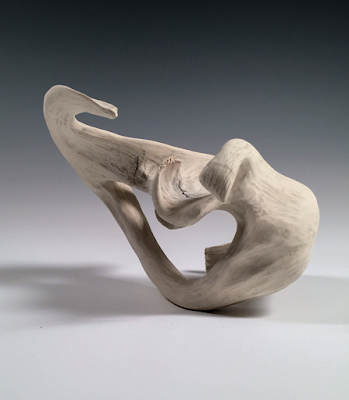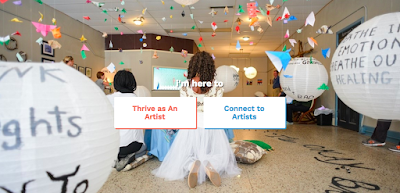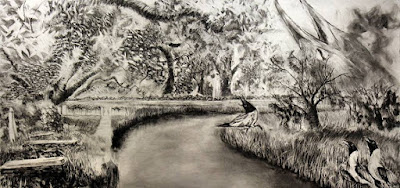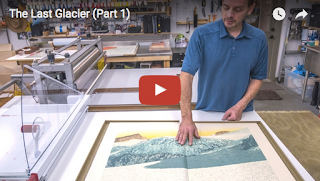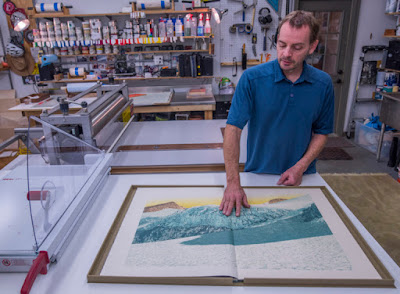 |
Todd Anderson, assistant professor of art and printmaking at Clemson
University, displays one of his reductive woodblock prints in “The Last
Glacier”, an artist book of 23 image plates of glaciers in Glacier
National Park, Montana, by him, Bruce Crownover and Ian van Coller.
Image Credit: Ken Scar / Clemson University |
Todd
Anderson, assistant professor of art and printmaking at Clemson
University, displays one of his reductive woodblock prints in “The Last
Glacier”, an artist book of 23 image plates of glaciers in Glacier
National Park, Montana, by him, Bruce Crownover and Ian van Coller.
CLEMSON — With a heavy mug of coffee in one hand, Todd Anderson moves
through his personal studio like a chef moving through a four-star
kitchen: fluidly, efficiently, among the tools of his trade: neatly
stacked cans of paint sorted by color, saws and drills tucked away
without a hint of sawdust, brushes hanging neatly, chisels gleaming.
Every label of every can and jar and bottle faces outward, lest
confusion disrupt the rhythm of his work.
Anderson, an assistant professor of
art
at Clemson University, is a printmaker, skilled at transferring beauty
and wonder from landscapes onto paper to share his experiences with the
public.
When guests arrive at his studio, which used to be his garage,
Anderson slips on a pair of shoes, turns off a stream of classical jazz
and begins to tell a story about his latest project, which recently
gained national attention.
“I think we all understand that the world is changing in sweeping and
dramatic ways,” Anderson says, his voice quiet and earnest. “My belief
is that those places need to be seen, they need to be experienced and
they need to be creatively documented.” It’s a holy trinity that guides
his work.
Since its founding 100 years ago,
Glacier National Park
has lost more than 80 percent of its glaciers. Over the past six years,
Anderson says, he hiked more than 500 miles through that park for a
project called
“The Last Glacier.” He
and two collaborators, painter Bruce Crownover and photographer Ian van
Coller, recently finished the project, resulting in original artwork
that includes 15 specially bound 25- by 38-inch books with Anderson’s
original prints, Crownover’s paintings and van Coller’s photos.
“My intent as an artist is to share the beauty of a changing world,” Anderson says.
In demand
The Metropolitan Museum of Art in New York and the New York Public
Library are sharing the work; they each bought a book on the spot. The
Library of Congress bought another. Clemson’s Emery A. Gunnin
Architecture Library, the University of Wisconsin-Madison, Yale, and
several private collectors have also invested in the artistic,
historical records.
The Last Glacier quickly garnered the kind of attention artists dream
of. But Anderson couldn’t look lighter, more carefree. He says he spent
a great deal of his life camping, hiking and climbing his way through
the Rocky Mountains, sleeping with the stars overhead. It’s easy to
picture him on a mountain in a three-day beard and a worn flannel shirt,
accidentally hip.
On being outside, Anderson says, “If you’ve felt frost on a sleeping
bag, or seen dew on cobwebs in the woods, you can understand the value
of that experience.”
Rock climbing shaped his arms and hands; they’re strong, purposeful.
His blue eyes sparkle with an infinite appreciation for wonder,
reflecting a scientist’s curiosity and exacting patience. There are
stories in those hands and eyes, and a quiet urgency to tell them.
An Anderson woodcut print of the Grinnell glacier in Glacier National Park.
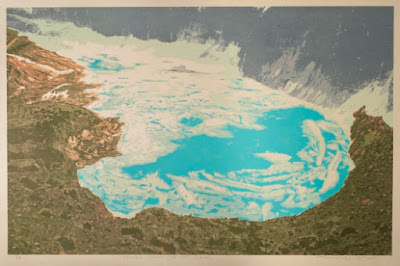 |
| An Anderson woodcut print of the Grinnell glacier in Glacier National Park. |
In the late oughts, Anderson heard the Rockies’ glaciers were
melting. “My first thought was, this is the environment that I love,
these alpine environments, the beauty of these places. I felt sad, first
and foremost. And then I thought, ‘Well, who is documenting these
places?’”
When months of searching for someone recording the glacial recession
turned up empty, Anderson decided to do it himself. “It was really out
of a sense of responsibility,” he says.
The three collaborators are currently wrapping up a second project,
documenting glaciers in Rocky Mountain National Park. Anderson is also
waiting to hear about a grant from the National Science Foundation that
would send him to Antarctica.
The Last Glacier is a compelling and invaluable work, said Gary
Machlis, the University Professor of Environmental Sustainability and
scientific adviser to the director of the National Park Service for
eight years until early January 2017. “Climate change is the
environmental challenge of our age, and responding to this challenge
requires a constellation of voices — including those of artists like
Todd.
“Art can be a portal for understanding in a visceral, emotional way
what science attempts to demonstrate through theory, data and analysis,”
Machlis said. “Todd’s work is powerful, and his collaborative team is
unique and so committed to their task. Viewing the images in ‘The Last
Glacier’ is a reminder of what is at risk and what might be lost if we
do not act.”
In 1910, there were 150 glaciers within the new 1 million-acre
Glacier National Park in Montana’s Rocky Mountains. When Anderson
started his work, in 2010, all but 25 had melted.
Glaciers, the marvelous remnants of the last ice age, are made from
the bottom up by layer upon layer of snow that melts into ice, the
accumulating weight pressing the earth, picking up and setting down
boulders as they slide incrementally. For the past 7,000 years, the
glaciers in the park have stretched for miles, like giant beached whales
caught between mountains and frozen by time.
 |
| Lakes dot a valley in Glacier National Park that a glacier once filled. Photo courtesy Todd Anderson. |
Melting ice, rising seas
Lakes dot a valley in Glacier National Park that a glacier once filled. Photo courtesy Todd Anderson.
When glaciers melt they don’t simply disappear, they become water. Increasingly, they’re adding to rising sea levels.
Melt from all the glaciers and ice sheets in the world are
responsible for two-thirds of global sea level rise (the rest is
attributed to warming seas), according to
Andrew Fountain a
glaciologist at Portland State University in Portland, Oregon, who
agreed to write a scientific note about the next project by Anderson and
his colleagues.
Twenty years ago, Fountain said, alpine glaciers, like the ones in
Glacier National Park, were the first to melt. “Now Greenland is
beginning to melt,” he said.
By 2040, with a 2-degree Celsius increase in global temperature, sea
levels will rise significantly along 90 percent of the world’s
coastlines, affecting hundreds of millions of people, according to
a study in the Proceedings of the National Academy of Sciences.
Fountain has introduced many artists to the wilderness in Antarctica,
where he conducts some of his research. When Anderson asked him, out of
the blue, to contribute to an artistic project, Fountain considered it a
way to tell more people about the melting glaciers.
“Getting this information out to people is super important,”
said Fountain. “It’s a gateway to science. I might be attracted to the
subject by graphs and plots, but others might be attracted by art.”
It’s a symbiotic relationship, Anderson said, as scientists wrap the art in a scientific context.
“Working with scientists is very critical to my projects. We’re
trying to bridge gaps and we’re trying to connect with as many folks as
we can,” Anderson said. “What the scientists provide is things that we
can’t provide – analytical analysis and whole, unique perspectives of
what’s going on with the landscape.”
There is also common ground among artists and scientists, and
aficionados of each. Science, Fountain said, can be incredibly creative,
like when it’s time to choose the right approach to finding a solution.
And when looking at Anderson’s art, the glaciologist sees clues to the
glacier’s life, such as whether it’s advancing or retreating.
Democratic medium
After graduating from the University of Wisconsin-Madison, Anderson
found work at Tandem Press, an international printing house affiliated
with UW’s School of Education. Tandem has a tradition of attracting
famous artists to experiment and print in its studio. David Lynch, Chuck
Close, Art Spiegelman and Judy Pfaff are among its alumni.
Essentially, Anderson worked with artists accustomed to producing
singular pieces of art and helped them create prints that “would be
totally and wholly unique, but you could make 20 or 30 of these things
and more people could have it.”
Printmaking, he said, “is an inherently democratic medium, and for me
that was really what grabbed me.” “The Last Glacier” project is
similarly intended to be shared with the masses, Anderson said. “Our
mission is to get the work into the public sphere,” he said.
And he wants future masses to experience the work, which makes
acquisitions by the Met, the New York Public Library and the Library of
Congress special.
“One of the things I want to do as an artist is to talk about the
immediacy of things going on in the world. But art, as I understand it
and the way I approach it, it’s a multigenerational conversation,”
Anderson said.
In museums, “when we look at a painting from the 1800s it helps us
understand what people’s values were, what people thought about.
“It’s just as important when future generations who go to museums and
get to see this work. It’s not just saying, ‘Oh, there used to be a
glacier here,’ but it’s also saying, ‘This is a little bit about us.’ In
a very, very small way. Of what we valued as a society and what we
thought about, the challenges we were trying to face and engage.”
Working with collaborators also amplifies the message and grows the
audience. Anderson initially planned to work alone, but the glaciers
were so vast and distant – 10 to 15 miles from an access road – that he
enlisted Crownover and van Coller to help cover the territory.
The result, Anderson said, is “three very unique artistic visions of
essentially the same thing. The hope is that by presenting the viewer
with three different versions of three different artists, that folks
might be able to latch on. If they don’t like my work, maybe they’ll
really like Bruce’s. Or if they don’t like Bruce’s, maybe they’ll like
Ian’s.”
Todd
Anderson, assistant professor of art and printmaking at Clemson
University, carves out a “stamp” to create a reductive woodcut print of a
glacier for “The Last Glacier”. (Photo by Ken Scar)
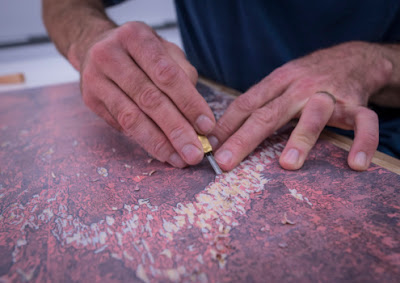 |
| Todd Anderson, assistant professor of art and printmaking at Clemson
University, carves out a “stamp” to create a reductive woodcut print of a
glacier for “The Last Glacier”. (Photo by Ken Scar) |
Mirroring the glaciers
If you’ve stood on a glacier, or on a mountain two miles high,
standing in front of Anderson’s finished prints will stir a familiar
chill in the air, as if someone opened a window 10,000 feet up. The
prints reveal scars from the violent upheaval, subduction and collision
of the Earth’s crust. You’ll feel the cool blues of the ice, the ancient
gray of the rock and yellow, purple, pink and blue of sunrises and
sunsets seen through thin air.
Anderson spent weeks each summer working in situ, researching the
glaciers – which ones to document, how to access them, seeing them at
different times of day as the sun shifted shadows and revealed new
details. He hiked, sketched and photographed, getting to know each one
before it ceased to exist.
Back in his studio, where the prints come to life, a mixture of
fluorescent bulbs balance the blues, reds and greens to shine as white
as possible.
In the middle of the space sits a printing press, perched atop tiny
feet, perfectly level. The press is new; at least it’s new to Anderson.
It arrived recently by freight to his home in one of Clemson’s leafy
neighborhoods. The press is his six-burner gas range, where the
ingredients of his art – science, nature, light and the wonder of the
Rocky Mountains — mingle and fuse.
Slowly, they develop as reductive woodcut prints in a process
involving time, pressure and the deliberate carving of a landscape until
nothing is left but a picture, a life cycle that mimics his subjects.
Anderson chose to recreate the glaciers as woodcut prints because, he
says, he wanted “an organic, visual language,” and woodcuts, by their
nature, provide a “visual texture.”
Both glaciers and prints are constructed of layers, but while
glaciers are built from the bottom, prints begin at the top. They
require the artist to complete the piece in his mind, then work
backward.
Anderson transfers a sketch to a rectangular block of basswood,
imported from Japan, then begins working in negative space – using
fingers and hands that once routinely clung to rock to slowly, expertly,
carve away wood, creating an image by removing what he doesn’t want in
the print. The first layer he carves away, from the top of the block,
will be the first image on the paper, the bottom layer of color.
“I might do that 10, 15 or 20 times. So I’ll have 15 or 20 sheets of
paper that look the same,” he says. “Once I’m done doing that, I’ll take
that same block of wood, clean it off, carve it out a little bit more,
I’ll ink it up with a new color this time, then I’ll print it on top of
what I printed before.”
He has to print light colors first, and he’s constantly calculating
“the value of the color and the opacity of my ink, so that I can make a
whole image look right. At least in my mind how it looks right.”
One layer, one carving, one color, one pressing at a time, all the
while thinking backwards, or upside down, removing negative space from
the top that becomes the bottom. Eventually, the full image appears.
But, at a cost.
“By the time I get done making these artworks, the blocks themselves
are really exhausted, and there’s no way of going back and remaking the
artwork,” Anderson says. “The process is mirroring the fate of the
glaciers themselves.”
Anderson said he doesn’t create “message” art. He’s not delivering a political statement. Not directly, anyway.
“There’s a complexity to these ideas” of art, experience, climate
change, he said. “What I’m trying to present as an artist is visual
complexity. But there’s moments where, when it works right, you can get
lost in these things and you start seeing the cobwebs. You start seeing
things. There’s an experience that art can give you, which is just
wonder, and that’s what I’m trying to do.”
Anderson received funding from the South Carolina Arts Commission,
the Sustainable Arts Foundation and the National Endowment for the Arts
for this work.
For more information, and to see the work by Crownover and van Coller, go to
TheLastGlacier.com.
For more information about Clemson's BFA in Art Program and to apply, go to:
To learn more about Clemson University's Master of Fine Arts in Art program and to apply, please go to:



